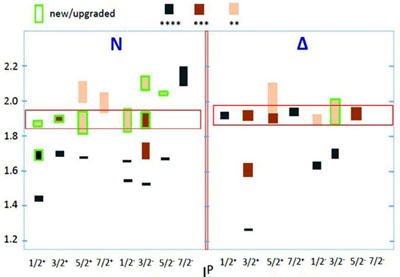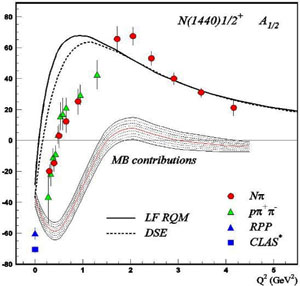
INSTITUTE FOR NUCLEAR THEORY
News
Home | Contact | Search | News archive | Site Map

|
INSTITUTE FOR NUCLEAR THEORY News
Home | Contact | Search | News archive | Site Map |
|||||
|
(INT Workshop 14-18 November 2016) Reported by V. D. Burkert, R. W. Gothe, V. Mokeev, C. D. Roberts, and A. Szczepaniak Date posted May 4, 2017 |
|
Two of the most basic goals of nuclear physics are to understand the mechanisms responsible for the formation of hadrons and explain their structure in terms of the gluons and quarks of quantum chromodynamics (QCD). In this connection, measurements of the nucleon excitation (N*) spectrum and exploration of N* structure through the study of resonance electro-excitation amplitudes (γνNN* electrocouplings) on a broad domain of photon virtualities (Q2) present unique opportunities for elucidating these crucial aspects of nonperturbative strong-interaction dynamics. The complexity of this problem is great, so a multipronged approach is necessary to achieve its solution.  
The nucleon resonance spectrum and structure from exclusive meson photo- and electroproduction data. (Left) Spectrum of excited nucleon states as of 2017. Information on new baryon states (highlighted by green boxes) emphasizes the major impact of recent CLAS KY photoproduction data. (Right) Consistent results on N(1440)1/2+ electrocouplings from CLAS Nπ and π+π−p electroproduction data. The description of this data provided by both DSE computations, with a traceable connection to QCD, and light-front quark models, defined with momentum-dependent quark masses, highlights that such data provide access to the mechanisms in strong-QCD that underlie hadron mass generation and reveals that N* structure emerges from a complex interplay between an inner core of dressed quarks and an external meson cloud.
This workshop built upon the success of earlier meetings - at JLab (2008, 2011), U. South Carolina (2012), and ECT* in Trento (2015) - with a continued focus on facilitating interactions between expert practitioners representing the various, complementary approaches to this challenging problem. The workshop gathered more than 30 participants, and explored themes ranging from basic theory through practical phenomenology and onto the means by which conjectures and predictions can be verified empirically via studies of exclusive electroproduction. The range and impact of this program will be greatly expanded by experiments enabled by the CLAS12 detector in the new JLab12 era.
CLAS12 is the only facility foreseen worldwide that will be able to search for hybrid baryons in electroproduction processes and, in providing access to an enormous range of final-state baryon quantum numbers with electroproduction transitions at up to Q2~12GeV2, it is uniquely capable of exposing many facets of the transition between the non-perturbative and perturbative domains of QCD. It follows that the associated experimental and theoretical programs, working together, will supply crucial insights concerning some of the most pressing questions in modern science, viz. what is the origin of more than 98% of the visible mass, how is it connected with confinement, and how both phenomena emerge from the Standard Model. |